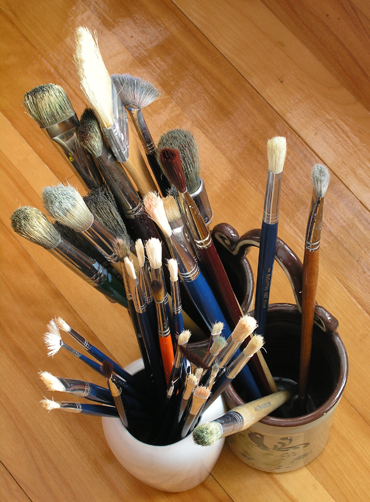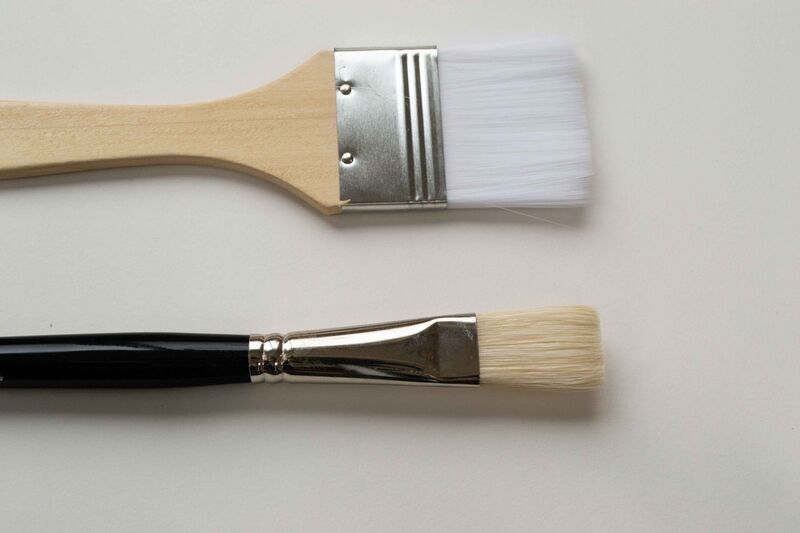One of the best parts of fabric painting is that you can display your beautiful masterpieces by wearing them, you are the canvas. Best Brushes for Fabric Painting One of the first steps in fabric painting is deciding what tools you need which may be a case of digging through your craft box or adding something new to your collection. So start with that first, go to a reputable art store to find the best painting brushes. And there are some really top brush companies in the world. One being Silver Grand Prix, another one being Treacle. Those two are certainly very good. So the type of brush that we use and we feel, and is the best is a hogs hair bristle brush. These canvas markers were handpicked by me personally and were chosen based on personal experience and reviews from other artists as well. Without further ado, let us take a look at some of the best paint pens for canvas you can find on the market.

Choosing the right paint brush seems like a simple decision, but the type of brush you choose has a big impact on the finished look of your painting job. Everything from the type of paint you use to the type of job helps determine which types of paint brushes work best.
Type of Bristles
The choice between natural and synthetic bristles is an important one. Natural bristles have a flagging or splitting at the tips, which helps produce a smooth finish and holds plenty of paint. Natural-bristle brushes are better suited for oil-based or solvent-based paints. The natural bristles are stronger, so they stand up to the chemicals and let you apply the paint without leaving marks.
Synthetic brushes come in different materials, such as nylon, polyester and a blend of nylon and polyester. These brushes are easy to use and clean up well. Synthetic brushes work best for water-based paint. Natural-bristle brushes draw moisture out of the water-based paint, making it difficult to apply properly.
Paint Brush Types Paint brushes are available in angled and flat styles. Angled brushes work well for cutting in along edges and getting straight lines. Choose a thin angled brush when you need a particularly crisp line. A thicker angled brush holds more paint and works well along ceilings and for painting trim. Flat brushes work well when painting a large, flat surface. Some flat brushes are designated for use on trim or for use on walls, with designs specific to those uses. |
Bristle Ends
The bristle ends affect how well the paint brush picks up paint and releases it onto the painted surface. Flagged or exploded bristles on higher-end brushes let you pick up more paint with each dip. The split ends also help the paint go on smoothly without brush marks.
Artist Paint Brushes For Sale
Brush Sizes
The size of the brush affects how well-suited it is for a particular job, including both the width of the bristle area and the thickness of the bristles. Thick brushes hold more paint to cover more ground before you need to reload, while thinner brushes are lighter and offer better control.
Choose a brush that is wide enough to cover efficiently, yet narrow enough for control over the paint application. If you're painting narrow trim, a wide brush doesn't work well. A 2- to 2-1/2-inch brush is a good general size that works for a variety of projects. If you're painting narrow trim or small spaces, opt for a 1-inch brush. Large, flat areas work best with a 4-inch brush so you can cover the surface faster.
Paint Brush Quality
No matter what type of paintbrush you choose, focus on the construction quality for the best results. Look for dense bristles throughout the ferrule. Test the brush by bending it back near the base. A solid paint brush springs back. A tapered design with a slim profile at the end and flagged tips allow for excellent control and even coverage.
Acrylic Paint And Brushes
Reach for a brush with quality construction and the type of bristles best-suited to your specific project. When you do, your clients get smooth, quality finishes that make them come back to you over and over.
What Are The Best Paint Brushes For Artists


Canvas is a classic surface for creating art. How to add neptune rising to kodi. But what is the best paint for canvas? Read on to learn the best and worst types of paint to use on canvas.
With so many paint options out there, it can be hard to know which medium is best suited for which painting surface. But you don’t have to learn the hard way. In this post, we’ll explore what paint to use on canvas by reviewing common painting media and explaining why they do or don’t work well on for painting on canvas.
The best types of paint for canvas
Acrylic
Acrylic paint is one of the most popular types of paint for painting on canvas, and with good reason. It’s easy to work with, requires minimal supplies and dries quickly. A primed canvas provides an ideal surface for acrylic, which can be applied with a brush or palette knife.
In terms of what type of acrylic paint to use, a thicker acrylic paint (sometimes called “heavy body”) will work best on canvas. Thinner acrylic paint (sometimes called “fluid acrylic”) will require a lot more paint to create an opaque layer, and can drip downward if painting on an easel.

Oil paint
Whether it’s traditional oil paint or water-soluble oil paint, oils are very well suited to painting on canvas. Their thick, viscous texture requires a heavy-duty painting surface to rest upon that won’t be degraded by oil, and a primed canvas provides just that. Like acrylic, oil paint can be applied either with a brush or a palette knife; it can even be applied without either, by using oil pigment bars (sort of like oil pastels).
So-so paints for canvas
Gouache
Gouache is a unique type of paint that has characteristics of both acrylic and watercolor paint. It is composed of color pigment with a binding agent such as gum arabic, often with a solid white pigment such as chalk (or sometimes even acrylic) incorporated. These two factors give gouache a much heavier texture and higher opacity than watercolor alone, but not quite the opacity of acrylic.
Gouache can be applied to canvas, but it is best to apply a fairly thick layer, with minimal water added. While gouache can be used on smaller paintings or to create effects like the gouache resist technique, painting on canvas can use up gouache very quickly, and you may find that using acrylic paint is a better choice.
Tempera
Best Acrylic Paint Brushes For Canvas
Tempera paint is made of pigment with a water-soluble binder (in old times, the binder was egg, hence the alternate name: “egg tempera”). Tempera can be used on canvas, but it’s not always an ideal medium. Like fluid acrylic, tempera paint is not extremely thick, so it can drip downward if applied to a canvas on an easel. Additionally, tempera paint is typically not permanent or archival, so while it is a great and inexpensive medium to explore painting with, it is not an ideal medium for painting on canvas in the long term.
What Paint Brushes To Use On Canvas
Latex paint
Did you know that Picasso used house paint to create many of his masterpieces? Truthfully, house paint works pretty well on a primed canvas; it’s usually fairly opaque and lightfast, and it can be bought in bulk for a fairly inexpensive price. The problem? House paint is not designed for painting on canvas, and its longevity can vary greatly. Where acrylic and oil paint are designed to last for years, the same cannot be said for house paint, which is designed to last for a few years, but not centuries. So don’t use house paint to create the masterpiece you want to hand down to future generations!
Not suggested for canvas
Watercolor
Watercolor is a beautiful painting medium, but it is not well suited to painting on canvas. The water-based paint tends to form beads and dry irregularly on canvas, especially a primed canvas.
While this could be fun to add effects to a mixed media painting, working in watercolor on canvas will likely be frustrating for creating a complete work of art. An absorbent watercolor paper is a far better choice.
